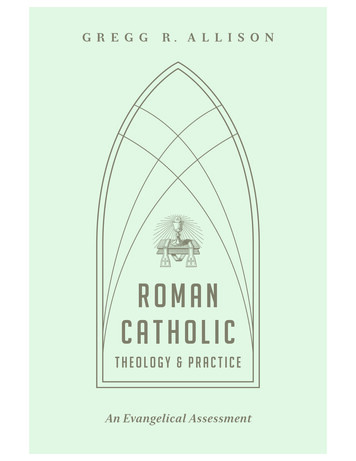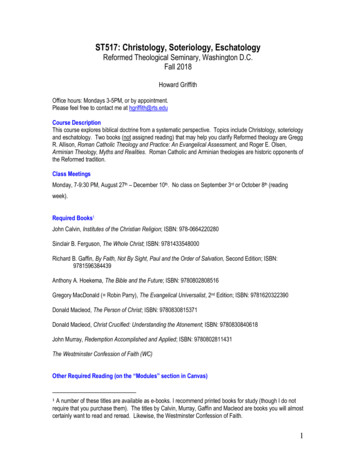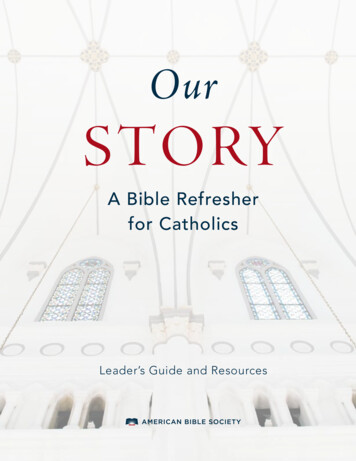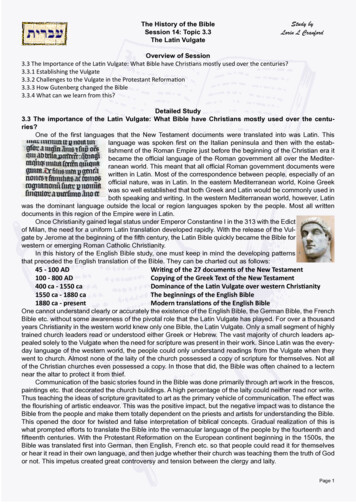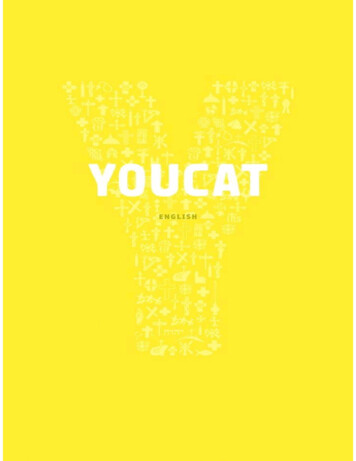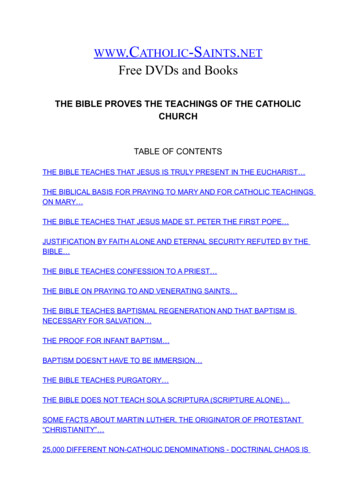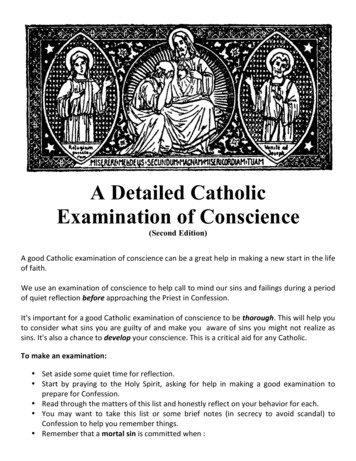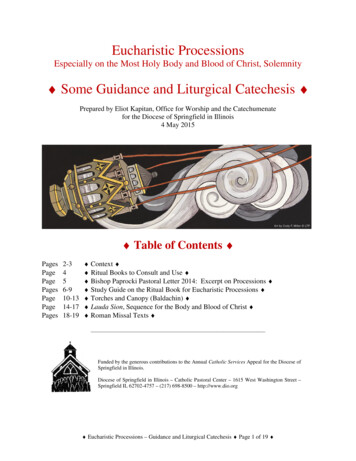
Transcription
Eucharistic ProcessionsEspecially on the Most Holy Body and Blood of Christ, Solemnity Some Guidance and Liturgical Catechesis Prepared by Eliot Kapitan, Office for Worship and the Catechumenatefor the Diocese of Springfield in Illinois4 May 2015 Table of Contents 8-19 Context Ritual Books to Consult and Use Bishop Paprocki Pastoral Letter 2014: Excerpt on Processions Study Guide on the Ritual Book for Eucharistic Processions Torches and Canopy (Baldachin) Lauda Sion, Sequence for the Body and Blood of Christ Roman Missal Texts Funded by the generous contributions to the Annual Catholic Services Appeal for the Diocese ofSpringfield in Illinois.Diocese of Springfield in Illinois – Catholic Pastoral Center – 1615 West Washington Street –Springfield IL 62702-4757 – (217) 698-8500 – http://www.dio.org Eucharistic Processions – Guidance and Liturgical Catechesis Page 1 of 19
Context ONE. The Most Holy Body and Blood of Christ (Corpus Christi) is a Solemnity that falls onthe Sunday after the Most Holy Trinity in the Dioceses of the United States. This annualcelebration occurs two weeks after Pentecost toward the beginning of summer in the return toOrdinary Time following the Great Easter 50-Days.The Ceremonial of Bishops offers this guidance for this Solemnity and for the procession that isassociated with it. It offers some rich concepts for preaching and for catechesis.385. The institution of the eucharist has as a special memorial the Mass of theLord’s Supper, when Christ the Lord shared a meal with his disciples and gavethem the sacrament of his body and blood to be celebrated in the Church. Thesolemnity of the Body and Blood of Christ (Corpus Christi) further proposes thecultus of the blessed sacrament to the faithful so that they may celebrate thewonderful works of God, signified by the sacrament and accomplished by thepaschal mystery of Christ. This solemnity is also intended to teach the faithfulhow to share in the eucharistic sacrifice and to have it more profoundly influencetheir life, to revere the presence of Christ the Lord in this sacrament, and to offerthe thanks due for God’s gifts.386. In its devotion the Church has handed down as a distinctive feature of thecelebration of this solemnity a procession in which the eucharist is carriedsolemnly and with singing through the streets, and the Christian people givepublic witness to their belief in the sacrament of the eucharist and to theirdevotion .TWO. The SACRED CONGREGATION FOR RITES Instruction Eucharisticum mysterium, on theEucharist, 25 May 1967, provides this guidance and norms concerning processions with the HolyEucharist during the initial time of reform following the Second Vatican Council. This excerptaddresses the necessary connection between devotional prayer and liturgical prayer, theimportance of public witness to faith, and the role of the diocesan Bishop for oversight.III. EUCHARISTIC DEVOTIONS58.Devotion, both private and public, toward the sacrament of the altar evenoutside Mass, that conforms to the norms laid down by lawful authority and in thepresent Instruction is strongly advocated by the Church, since the eucharisticsacrifice is the source and summit of the whole Christian life [LG, no. 11].In structuring these devotional exercises, account should be taken of thenorms determined by Vatican Council II concerning the relationship to beobserved between the liturgy and other, nonliturgical sacred services. Particularattention should be paid to this one: “These devotions should be so fashioned thatthey harmonize with the liturgical seasons, accord with the sacred liturgy, are insome way derived from it, and lead the people to it, since, in fact, the liturgy, byits very nature far surpasses any of them” [SC, no. 13]. Eucharistic Processions – Guidance and Liturgical Catechesis Page 2 of 19
IV. EUCHARISTIC PROCESSIONS59.In processions in which the eucharist is carried through the streetssolemnly with singing, especially on the feast of Corpus Christi, the Christianpeople give public witness to their faith and their devotion toward this sacrament.However, it is for the local Ordinary to decide on both the advisability ofsuch processions in today’s conditions and on a place and plan for them that willensure their being carried out with decorum and without any loss of reverencetoward this sacrament.THREE. The CONGREGATION FOR THE SACRAMENTS AND DIVINE WORSHIP InstructionInaestimabile donum, norms for the worship of the Eucharistic mystery, 4 April, 1980. Thisexcerpt notes the need of attending to the norms of the ritual books:22.With regard to exposition of the holy eucharist, either prolonged or brief,and with regard to processions of the blessed sacrament, eucharistic congressesand the whole ordering of eucharistic piety, the pastoral indications and directionsgiven in the Roman Ritual are to be observed.FOUR. UNITED STATES CONFERENCE OF CATHOLIC BISHOPS approved ritual book, Order forthe Solemn Exposition of the Holy Eucharist: Presider's Edition [OSEHE], providesadditional clarity with these norms:20.Processions within the body of a church are no longer permitted [Notitiae11 (1975, 64]. A procession with the blessed sacrament should go from onechurch to another. Nevertheless, if local circumstances require, the processionmay return to the same church where it began [HCWEOM, no. 107].21.In the course of the procession there may be stations where the eucharisticblessing is given, if there is such a custom and some pastoral advantagerecommends it. Songs and prayers should be planned with the purpose ofexpressing the faith of the participants and the centering of their attention on theLord alone [Notitiae 4 (1968, 133-134].FIVE. Finally, the Roman Missal, Third Editions provides this rubric at the end of the texts forthe Most Holy Body and Blood of Christ:It is desirable that a procession take place after the Mass in which the Host to becarried in the procession is consecrated. However, nothing prohibits a processionfrom taking place even after a public and lengthy period of adoration followingthe Mass. If a procession takes place after Mass, when the Communion of thefaithful is over, the monstrance in which the consecrated host has been placed isset on the altar. When the Prayer after Communion has been said, the ConcludingRites are omitted and the procession forms. Eucharistic Processions – Guidance and Liturgical Catechesis Page 3 of 19
Ritual Books to Consult and Use Lectionary for Mass [LM] Year A: LM, no. 167A [in the years 2017, 2020, 2023, 2026, etc.]Deuteronomy 8:2-3, 14b-16a – He gave you a food unknown to you and your fathers.Psalm 147:12-13, 14-15, 19-20 – (12) Praise the Lord, Jerusalem.1 Corinthians 10:16-17 – The bread is one, and we, though many, are one body.[Sequence: Lauda Sion] *Alleluia: John 6:51 – I am the living bread that came down from heaven, says the Lord; /whoever eats this bread will live forever.John 6:51-58 – My flesh is true food, and my blood is true drink. Year B: LM, no. 168B [in the years 2015, 2018, 2021, 2024, etc.]Exodus 24:3-8 – This is the blood of the covenant that the Lord has made with you.Psalm 116:12-13, 15-16, 17-18 – (13) I will take the cup of salvation and call on thename of the Lord.Hebrews 9:11-15 – The blood of Christ will cleanse our consciences.[Sequence: Lauda Sion] *Alleluia: John 6:51 – I am the living bread that came down from heaven, says the Lord; /whoever eats this bread will live forever.Mark 14:12-16, 22-26 – This is my body. This is my blood. Year C: LM, no. 169C [in the years 2016, 2019, 2022, 2025, etc.]Genesis 14:18-230 – Melchizedek brought out bread and wine.Psalm 110:1, 2, 3, 4 – (4b) You are a priest forever, in the line of Melchizedek.1 Corinthians 11:23-26 – For as often as you eat and drink, you proclaim the death of theLord.[Sequence: Lauda Sion] *Alleluia: John 6:51 – I am the living bread that came down from heaven, says the Lord; /whoever eats this bread will live forever.Luke 9:11b-17 – They all ate and were satisfied.* Note: [Sequence: Lauda Sion] – the brackets denote that this is optional.Roman Missal, Third Edition – Proper prayers for The Most Holy Body and Blood ofChrist are found toward the very end of the Proper of Time in the section “The Solemnities of theLord during Ordinary Time”.Holy Communion and Worship of the Eucharist outside Mass [HCWEOM], nos.101-108.Order for the Solemn Exposition of the Holy Eucharist: Presider's Edition[OSEHE], nos. 17-25. Eucharistic Processions – Guidance and Liturgical Catechesis Page 4 of 19
Bishop Paprocki Pastoral Letter 2014 Excerpt on ProcessionsBishop Thomas John Paprocki wrote Ars celebrandi et adorandi A Pastoral Letter on the Art ofCelebrating the Eucharistic Liturgy Properly and Adoring the Lord in the Eucharist Devoutly.He issued it on 22 June 2014, the Solemnity of the Body and Blood of Christ. The seventhsegment treats Processions with the Blessed Sacrament. He wrote in part:34.Pope Benedict XVI spoke eloquently about the meaning of the CorpusChristi procession for contemporary Catholics in his homilies for the feast. Theprocession is a profession of faith: the Solemnity of Corpus Christi developed at atime when Catholics were both affirming and defining their faith “in Jesus Christ,alive and truly present in the Most Holy Sacrament of the Eucharist,” and theprocession is a public statement of that belief. The sacrament of the Lord’s Bodyand Blood always “goes above and beyond the walls of our churches.” Theprocession blurs the separation between what we do inside the church, and whatwe do outside: we immerse Christ, so to speak, “in the daily routine of our lives,so that he may walk where we walk and live where we live.” Pope Benedictdeclared, “The procession represents an immense and public blessing for ourcity.” 1935.The Code of Canon Law encourages liturgical processions outside thechurch, “When it can be done in the judgment of the diocesan bishop, as a publicwitness of the veneration toward the Most Holy Eucharist, a procession is to beconducted through the public streets, especially on the solemnity of the Body andthe Blood of Christ.” 20 The leading of processions outside the church is amongthe specific liturgical functions especially entrusted to the pastor. 2136.I highly encourage and give permission for pastors to conduct processionswith the Blessed Sacrament through the public streets, especially on the solemnityof the Body and the Blood of Christ, as a witness to our faith in the Real Presenceof Our Lord in the Eucharist and as an expression of our belief that God is in ourmidst even in our everyday lives. Suitable arrangements are to be made withpublic authorities and local law enforcement officials for the safety of theparticipants.19 See Homily of His Holiness Benedict XVI, Thursday, 7 June 2007,http://www.vatican.va/holy father/benedict xvi/homilies/2007/documents/hf benxvi hom 20070607 corpus-christi en.html, and Homily of His Holiness Benedict XVI, Thursday, May 26, 2005,http://www.vatican.va/holy father/benedict xvi/homilies/2005/documents/hf benxvi hom 20050526 corpusdomini en.html.20 Code of Canon Law, Canon 944.21 Code of Canon Law, Canon 530. Eucharistic Processions – Guidance and Liturgical Catechesis Page 5 of 19
Study Guide on theRitual Book for Eucharistic Processions Holy Communion and Worship of the Eucharist outside Mass[HCWEOM].Includes the General Introduction; (1) Rite of DistributingHoly Communion outside Mass; (2) Administration of Communionand Viaticum to the Sick by an Extraordinary Minister; (3) Forms ofWorship of the Holy Eucharist – Exposition, Processions,Congresses; (4) Texts; and Appendix.New York: Catholic Book Publishing Corp., 1976.ISBN: 0-89942-648-4, hardback, 144 pp, 5 ½ x 8 ¼, 1ribbon, 14.95, Catholic Book Product Code: 648/22.ROMAN RITUAL.Holy Communion and Worship ofthe Eucharist outside Mass[HCWEOM],1976.Guidance for Ritual Celebration2.EUCHARISTIC PROCESSIONS101. When the eucharist is carriedthrough the streets in a solemnprocession with singing, theChristian people give public witnessof faith and devotion toward thesacrament.1.This procession is Liturgy in the formal sense, aliturgical act of walking with the Lord.2.Since a solemn procession gives public witness,great care is taken in planning and preparation.3.Singing is a necessary part of the procession.Hymns and through-composed songs are difficult tomaintain in a long procession. The choir can more easily maintain tempo andpitch when they stand and walk together. Butthey are hard to hear by those farther back in theprocession. Spreading musicians two-by-twothroughout the procession creates its owndifficulties making it more difficult formusicians to hear other musicians. Singing an un-memorized text off a song sheetwhile walking is also difficult. Familiar refrains,antiphons, and acclamations are easier tomaintain in procession. “Walkable” instruments are a blessing: thesounds of hand bells and drums carry well andwill help maintain both pitch and tempo. Eucharistic Processions – Guidance and Liturgical Catechesis Page 6 of 19
Consider other instruments that are typically partof marching bands. Some silence is also fitting.4.Other ways of suitable praying may also takeplace as long as it is focused on the Lord alone[HCWEOM, no. 107 and OSEHE, no. 21].It is for the local Ordinary,however, to judge whether this isopportune in today’s circumstances,and to determine the time, place, andorder of such processions, so thatthey may be conducted with dignityand without loss of reverence to thesacrament. 125.Bishop Paprocki encourages and givespermission to pastors to conduct processions especiallyon the Most Holy Body and Blood of Christ.6.He also requires that suitable arrangements aremade with public authorities and local law enforcementofficials.7.See Pastoral Letter Ars celebrandi et adorandi,no. 36.102. The annual procession on thefeast of Corpus Christi, or on anappropriate day near this feast, has aspecial importance and meaning forthe pastoral life of the parish or city.It is therefore desirable to continuethis procession, in accordance withthe law, when today’s circumstancespermit and when it can truly be asign of common faith and adoration.In the principal districts oflarge cities there may be additionaleucharistic processions for pastoralreasons at the discretion of the localOrdinary. If the procession cannotbe held on the feast of CorpusChristi, it is fitting to hold some kindof public celebration for the entirecity or its principal districts in thecathedral church or other appropriateplaces.8.In towns and cities with more than one parish,pastors my wish to collaborate on a single jointprocession. This may easily accommodate the Church’sdesire for “the procession to go from one church toanother” whenever possible [HCWEOM, no. 107 andOSEHE, no. 20].103. It is fitting that a eucharisticprocession begin after the Mass inwhich the host to be carried inprocession has been consecrated. Aprocession may also take place,however, at the end of a lengthyperiod of public adoration.9.It is ideal that Mass of the day immediatelyprecede the procession. At the end of Holy Communion,the monstrance is prepared and placed on the altar. Allmay sit for the usual brief silence. A Song of Praise maythen be sung. The Prayer after Communion is prayed inthe usual way. The Sacrament is incensed and theprocession begins. Eucharistic Processions – Guidance and Liturgical Catechesis Page 7 of 19
10. Alternately, at the end of Communion, a periodof lengthy Adoration of the Holy Eucharist may beginafter the Prayer after Communion with the processionfollowing it at a later published time. This may behelpful to accommodate the needs of a neighboringparish or for public safety.11. See the rubrics and outline below for details.104. Eucharistic processionsshould be arranged in accordancewith local customs concerning thedecoration of the streets and theorder followed by the participants.In the course of the procession theremay be stations where the eucharisticblessing is given, if this custom is ineffect and is of pastoral advantage.Songs and prayers should be directedthat all proclaim their faith in Christand direct their attention to the Lordalone.12. The custom of stopping at stations for the givingof a Eucharistic blessing is not required but may takeplace as per the norms in HCWEOM, no. 104.13. An advantage for stopping at stations is that aworship aid with songs and other prayers may moreeasily be used while the assembly is standing. Preparein advance that all may hear by how the assembly isgathered at the station and by use of a sound system ifthat is possible.14. The songs and prayers must focus on Jesus Christthe Lord alone.15. There may a reading with some brief preachingon an aspect of the Eucharistic presence and mystery.16. The Eucharistic blessing may be given. It is notrequired at the station(s) especially if all in theprocession continue into the church for Benediction atthe end.105.The priest whocarries the blessed sacramentmay wear the vestments usedfor the celebration of Mass ifthe procession takes placeimmediately afterward, or hemay vest in a white cope.17. A procession is not permitted to remain inside thechurch building [OSEHE, no. 20].106.Lights, incense,and the canopy under whichthe priest carrying the blessedsacrament walks should beused in accordance with localcustoms.18. A canopy (baldachin) is not required. Its usedepends on local custom.19. Although the ritual books do not give an order ofthe procession (it, too, is left to local custom) theCeremonial of Bishops does. This order may help parishplanning: Crossbearer, accompanied by candlebearersClergy wearing copes or vestments for MassDeacon of the MassCenserbearer with burning incensePriest carrying the Blessed Sacrament [walking Eucharistic Processions – Guidance and Liturgical Catechesis Page 8 of 19
20. under a canopy if it is used] and accompanied bytorchbearersThe people [carrying lighted candles]Additionally:Suitable bannersMusical instruments107.It is fitting that theprocession should go fromone church to another.Nevertheless, if localcircumstances require, theprocession may return to thesame church where it began.108.At the end of theprocession benediction withthe blessed sacrament shouldbe given in the church wherethe procession ends or atanother appropriate place.Then the blessed sacrament isreposed.12. See Congregation for Rites, instructionEucharisticum mysterium, no. 59: AAS 59 (1967)570.Note 1. See the companion document, “Exposition of the Holy Eucharist: Some LiturgicalCatechesis” prepared by Eliot Kapitan, Office for Worship and the Catechumenate for theDiocese of Springfield in Illinois, 17 February 2015. It provides guidance on Exposition andBenediction: Ritual Books for Exposition of the Holy Eucharist Outline – Exposition of the Holy Eucharist Some Liturgical Catechesis (bulletin shorts)It is accessible on the diocesan website, worship pages, Rites to Use, at this direct s to Use/Exposition-LitCatechesis Feb2015 final.pdf.Note 2. After all the preparation, the procession may be called off or delayed because ofweather. Since a procession is no longer permitted inside the church building [OSEHE, no. 20],a suitable time for Adoration follows the Exposition on the altar that includes song, prayer, andsilence. Conclude this liturgical praying with Benediction in the usual way. Eucharistic Processions – Guidance and Liturgical Catechesis Page 9 of 19
Torches and Canopy (Baldachin) Torches or lanterns are designed for carrying candles in procession outdoors. The candle maybe housed within red or clear glass. When the Holy Eucharist is exposed, four to six candles areused [HCWEOM, no. 85].A canopy (also called a baldachin) is not required. It does, however, provide these advantages:it creates a sacred space for the Eucharist, it protects the monstrance from falling objects andfalling light rain, it keeps the Eucharist “visible” to everyone in procession, and it can frame thespace at the outside station.When the poles of the canopy are long enough – eight to nine feet – then they may rest on theground over the designed station for song and prayer. A small pedestal of suitable height, largeenough to hold the monstrance, permits the Priest to set it down (and rest his arms) during thepraying.The size for this canopy is typically from 4.5 x 4.5 feet to 5 x 7 feet. The edges that drop downmay be from 8 to 12 inches deep. Poles for each corner should be 8 to 9 feet. Two horizontalpoles running front to back under the top of the fabric can help stabilize the canopy. Purchase ofa canopy from a church supply house or artist can easily range from 1000.00 to 4000.00 or 5000.00. Parishioners may be willing to design and make a suitable canopy. Give themenough time to accomplish this task.These images will help this design and fabrication task.Saints James and Patrick Parish, Decatur IL.Diocese of Springfield in IllinoisThis shows the beginning of the procession of several parishes and hospital leaving theparish campus. Note the four torches at the sides. Note the Jubilee 2003 banners. Eucharistic Processions – Guidance and Liturgical Catechesis Page 10 of 19
Cathedral of the Immacultate Conception, Springfield ILDiocese of Springfield in Illinois2014 Eucharistic Processions – Guidance and Liturgical Catechesis Page 11 of 19
Eucharistic Processions – Guidance and Liturgical Catechesis Page 12 of 19
Eucharistic Processions – Guidance and Liturgical Catechesis Page 13 of 19
Lauda Sion Sequence for the Body and Blood of ChristThe optional sequence for the Solemnity of the Most Holy Body and Blood of Christ is Laud, OZion (Lauda Sion). It has a long and a shorter form. It may be used in various ways during theprocession, especially if it is not sung during the Liturgy of the Word before the Alleluia. Forexample: Some beginning verses may be sung in the church as the procession is organized andbegins. Some verses may be sung while standing for prayer at a station. The final verses (shorter form) may be sung after the procession enters the church andpeople take their places for Benediction. Musicians may choose a common or familiar psalm tone for this singing.Laud, O Zion, your salvation,Laud with hymns of exultation,Christ, your king and shepherd true:Bring him all the praise you know,He is more than you bestow.Never can you reach his due.Special theme for glad thanksgivingIs the quick’ning and the livingBread today before you set:From his hands of old partaken,As we know, by faith unshaken,Where the Twelve at supper met.Full and clear ring out your chanting,Joy nor sweetest grace be wanting,From your heart let praises burst: Eucharistic Processions – Guidance and Liturgical Catechesis Page 14 of 19
For today the feast is holden,When the institution oldenOf that supper was rehearsed.Here the new law’s new oblation,By the new king’s revelation,Ends the form of ancient rite:Now the new the old effaces,Truth away the shadow chases,Light dispels the gloom of night.What he did at supper seated,Christ ordained to be repeated,His memorial ne’er to cease:And his rule for guidance taking,Bread and wine we hallow, makingThus our sacrifice of peace.This the truth each Christian learns,Bread into his flesh he turns,To his precious blood the wine:Sight has fail’d, nor thought conceives,But a dauntless faith believes,Resting on a pow’r divine. Eucharistic Processions – Guidance and Liturgical Catechesis Page 15 of 19
Here beneath these signs are hiddenPriceless things to sense forbidden;Signs, not things are all we see:Blood is poured and flesh is broken,Yet in either wondrous tokenChrist entire we know to be.Whoso of this food partakes,Does not rend the Lord nor breaks;Christ is whole to all that taste:Thousands are, as one, receivers,One, as thousands of believers,Eats of him who cannot waste.Bad and good the feast are sharing,Of what divers dooms preparing,Endless death, or endless life.Life to these, to those damnation,See how like participationIs with unlike issues rife.When the sacrament is broken,Doubt not, but believe ‘tis spoken,That each sever’d outward tokendoth the very whole contain.Nought the precious gift divides,Breaking but the sign betidesJesus still the same abides,still unbroken does remain. Eucharistic Processions – Guidance and Liturgical Catechesis Page 16 of 19
The shorter form of the sequence begins here.Lo! the angel’s food is givenTo the pilgrim who has striven;see the children’s bread from heaven,which on dogs may not be spent.Truth the ancient types fulfilling,Isaac bound, a victim willing,Paschal lamb, its lifeblood spilling,manna to the fathers sent.Very bread, good shepherd, tend us,Jesu, of your love befriend us,You refresh us, you defend us,Your eternal goodness send usIn the land of life to see.You who all things can and know,Who on earth such food bestow,Grant us with your saints, though lowest,Where the heav’nly feast you show,Fellow heirs and guests to be.Amen. Alleluia.Excerpt from the Lectionary for Mass.The Solemnity of the Most Holy Body and Blood of Christ.This poetic English translation of the sequence of the Roman Missal is taken from the Roman Missal approved by the NationalConference of Catholic Bishops of the United States 1964 by the National Catholic Welfare Conference, Inc. All rightsreserved. Eucharistic Processions – Guidance and Liturgical Catechesis Page 17 of 19
Roman Missal Texts [In the Dioceses of the United States]Sunday after the Most Holy TrinityThe Most Holy Body and Blood of Christ(CORPUS CHRISTI)SolemnityEntrance AntiphonHe fed them with the finest wheatand satisfied them with honey from the rock.Cf. Ps 81 (80): 17CollectO God, who in this wonderful Sacramenthave left us a memorial of your Passion,grant us, we pray,so to revere the sacred mysteries of your Body and Bloodthat we may always experience in ourselvesthe fruits of your redemption.Who live and reign with God the Fatherin the unity of the Holy Spirit,one God, for ever and ever.Prayer over the OfferingsGrant your Church, O Lord, we pray,the gifts of unity and peace,whose signs are to be seen in mysteryin the offerings we here present.Through Christ our Lord.Preface II of the Most Holy EucharistThe Fruits of the Most Holy EucharistIt is truly right and just, our duty and our salvation,always and everywhere to give you thanks,Lord, holy Father, almighty and eternal God,through Christ our Lord.For at the Last Supper with his Apostles,establishing for the ages to come the saving memorial of the Cross,he offered himself to you as the unblemished Lamb,the acceptable gift of perfect praise.Nourishing your faithful by this sacred mystery,you make them holy, so that the human race,bounded by one world, Eucharistic Processions – Guidance and Liturgical Catechesis Page 18 of 19
may be enlightened by one faithand united by one bond of charity.And so, we approach the table of this wondrous Sacrament,so that, bathed in the sweetness of your grace,we may pass over to the heavenly realities here foreshadowed.Therefore, all creatures of heaven and earthsing a new song in adoration,and we, with all the host of Angels,cry out, and without end we acclaim:Holy, Holy, Holy Lord God of hosts . . .Communion AntiphonWhoever eats my flesh and drinks my bloodremains in me and I in him, says the Lord.Jn 6: 57Prayer after CommunionGrant, O Lord, we pray,that we may delight for all eternityin that share in your divine life,which is foreshadowed in the present ageby our reception of your precious Body and Blood.Who live and reign for ever and ever.ACKNOWLEDGEMENTSExcerpts from the English translation of the Eucharisticum mysterium from Documents on the Liturgy: 1963-1979 1982,International Commission on English in the Liturgy Corporation (ICEL); Holy Communion and Worship of the Eucharist outsideMass, 1974, ICEL; Inaestimabile donum 1980, ICEL; the Ceremonial of Bishops, 1989, ICEL; the Lectionary for Mass,second typical edition 1997, 1981, 1968, ICEL; and the Roman Missal 2010, ICEL. All rights reserved. Reprinted withpermission.The poetic English translation of the sequence of the Roman Missal is taken from the Roman Missal approved by the NationalConference of Catholic Bishops of the United States 1964 by the National Catholic Welfare Conference, Inc. All rightsreserved.Art work by Cody F. Miller in Keeping the Seasons: Lent-Triduum-Easter 2015 2015, Archdiocese of Chicago. All rightsreserved. Reprinted with permission. Eucharistic Processions – Guidance and Liturgical Catechesis Page 19 of 19
given in the Roman Ritual are to be observed. FOUR. UNITED STATES CONFERENCE OF CATHOLIC BISHOPS approved ritual book, Order for the Solemn Exposition of the Holy Eucharist: Presider's Edition [OSEHE], provides additional clarity with these norms: 20. Processions within the body of
